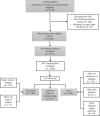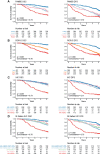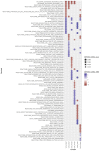The Transcriptomic Portrait of Locally Advanced Breast Cancer and Its Prognostic Value in a Multi-Country Cohort of Latin American Patients
- PMID: 35433488
- PMCID: PMC9007037
- DOI: 10.3389/fonc.2022.835626
The Transcriptomic Portrait of Locally Advanced Breast Cancer and Its Prognostic Value in a Multi-Country Cohort of Latin American Patients
Abstract
Purposes: Most molecular-based published studies on breast cancer do not adequately represent the unique and diverse genetic admixture of the Latin American population. Searching for similarities and differences in molecular pathways associated with these tumors and evaluating its impact on prognosis may help to select better therapeutic approaches.
Patients and methods: We collected clinical, pathological, and transcriptomic data of a multi-country Latin American cohort of 1,071 stage II-III breast cancer patients of the Molecular Profile of Breast Cancer Study (MPBCS) cohort. The 5-year prognostic ability of intrinsic (transcriptomic-based) PAM50 and immunohistochemical classifications, both at the cancer-specific (OSC) and disease-free survival (DFS) stages, was compared. Pathway analyses (GSEA, GSVA and MetaCore) were performed to explore differences among intrinsic subtypes.
Results: PAM50 classification of the MPBCS cohort defined 42·6% of tumors as LumA, 21·3% as LumB, 13·3% as HER2E and 16·6% as Basal. Both OSC and DFS for LumA tumors were significantly better than for other subtypes, while Basal tumors had the worst prognosis. While the prognostic power of traditional subtypes calculated with hormone receptors (HR), HER2 and Ki67 determinations showed an acceptable performance, PAM50-derived risk of recurrence best discriminated low, intermediate and high-risk groups. Transcriptomic pathway analysis showed high proliferation (i.e. cell cycle control and DNA damage repair) associated with LumB, HER2E and Basal tumors, and a strong dependency on the estrogen pathway for LumA. Terms related to both innate and adaptive immune responses were seen predominantly upregulated in Basal tumors, and, to a lesser extent, in HER2E, with respect to LumA and B tumors.
Conclusions: This is the first study that assesses molecular features at the transcriptomic level in a multicountry Latin American breast cancer patient cohort. Hormone-related and proliferation pathways that predominate in PAM50 and other breast cancer molecular classifications are also the main tumor-driving mechanisms in this cohort and have prognostic power. The immune-related features seen in the most aggressive subtypes may pave the way for therapeutic approaches not yet disseminated in Latin America.
Clinical trial registration: ClinicalTrials.gov (Identifier: NCT02326857).
Keywords: Latin America; PAM50 subtypes; biological pathways; breast cancer; risk of recurrence.
Copyright © 2022 Llera, Abdelhay, Artagaveytia, Daneri-Navarro, Müller, Velazquez, Alcoba, Alonso, Alves da Quinta, Binato, Bravo, Camejo, Carraro, Castro, Castro-Cervantes, Cataldi, Cayota, Cerda, Colombo, Crocamo, Del Toro-Arreola, Delgadillo-Cisterna, Delgado, Dreyer-Breitenbach, Fejerman, Fernández, Fernández, Fernández, Franco-Topete, Gabay, Gaete, Garibay-Escobar, Gómez, Greif, Gross, Guerrero, Henderson, Lopez-Muñoz, Lopez-Vazquez, Maldonado, Morán-Mendoza, Nagai, Oceguera-Villanueva, Ortiz-Martínez, Quintero, Quintero-Ramos, Reis, Retamales, Rivera-Claisse, Rocha, Rodríguez, Rosales, Salas-González, Sanchotena, Segovia, Sendoya, Silva-García, Trinchero, Valenzuela, Vedham, Zagame, United States-Latin American Cancer Research Network (US-LACRN) and Podhajcer.
Conflict of interest statement
The authors declare that the research was conducted in the absence of any commercial or financial relationships that could be construed as a potential conflict of interest.
Figures







References
Associated data
LinkOut - more resources
Full Text Sources
Medical
Research Materials
Miscellaneous

